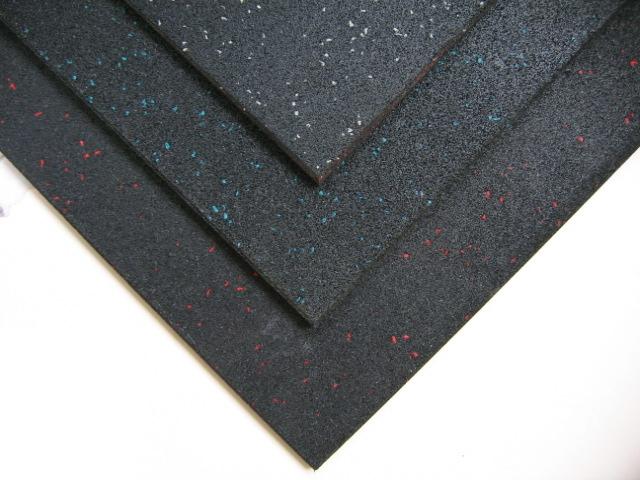Let’s assume you’re laying rubber down on a concrete subfloor, such as in a garage or commercial space. For other situations, see below.
Most commercial gyms, such 24 Hour Fitness and other chains, do fine with 1/2″ rubber flooring. This works as good quality flooring, whether in rolls or mats, and it does protect the concrete against occasional dropped dumbbells.
For Crossfit workouts involving regularly dropping the barbell in free-fall when doing cleans or snatches, 3/4″ rubber will best protect the concrete subfloor.
You need this kind of protection whether you’re dropping 200 lbs or 500 lbs. The force, including momentum, of a 200lb weight being dropped is many times greater than 200 lbs.
As an aside, we see that also with people dropping barbells onto the safety bars of power racks during a failed rep. The rack and bar both are meant to handle a certain amount of weight, but once you factor that kind of momentum into it, the static load limit goes out the window and all bets are off.
Even with rubber flooring, it isn’t unusual for Crossfit affiliates to peek under the mats and see that the regular workouts by their members have done a bit of pulverizing to the concrete.
You can take an extra measure to protect the floor by using economy bumper plates instead of the harder competition bumper plates. Economy bumpers have more bounce to them, making for a softer blow even when it’s the relatively dead-blow bounce like most are, whereas the competition bumpers transfer more energy into the floor with a dead-blow that’s closer to what iron plates would be (please don’t drop iron plates!).
To totally solve the problem you can drop extra layers of rubber or get a lifting platform, which typically has one or two layers of plywood and rubber on top.
On Non-Concrete Floors
Without concrete, you’re probably looking at some kind of wood or vinyl subfloor, particularly in a residential building.
Get 3/4″ if you can.
Over carpet it’s best to lay down some 3/4″ (or 23/32″ or 18mm) plywood. Make sure it’s flat. Get the good stuff. Lay the rubber on top of that. With commercial low-pile carpet you could lay the rubber directly on top of the carpet because it’s already so hard and won’t mess with the stability of your footing. With really plush carpet, you know what, it’s just bad for lifting on. Plush carpet might help protect the floor a little on its own, but not that well, and you’ll be dripping sweat all over it that takes a good steam cleaning to get out.
You will probably be ok with the occasional accidental drop of a dumbbell or plate. But as you can imagine, most people aren’t fans of testing this out, and we don’t have a lot of data on how often people can get away with this without creating a several thousand dollar repair bill. This will fall into the “That was loud, that sounded like you broke something” category.
You better not plan on dropping your barbell when doing cleans. It’s possible to do them without drops if you’re careful and perfect your form, at least until you deal with weights near you max. For snatches, you have to plan on the occasional drop both in front of and behind you, so it’s a bad idea to do snatches at all when you’ve got this kind of floor.
Also see our article, Gym Flooring Guide: Rubber Mats and Rolls

